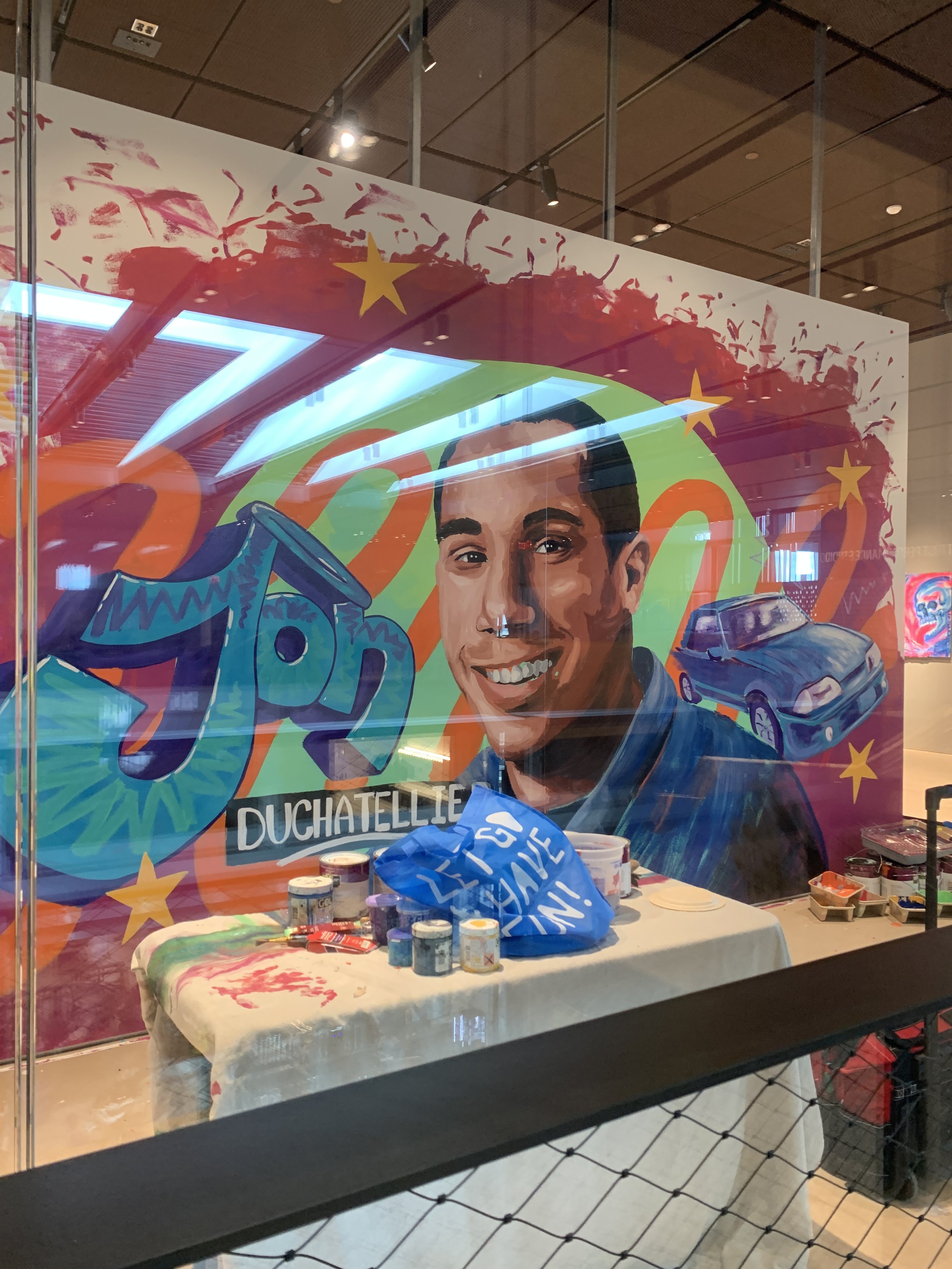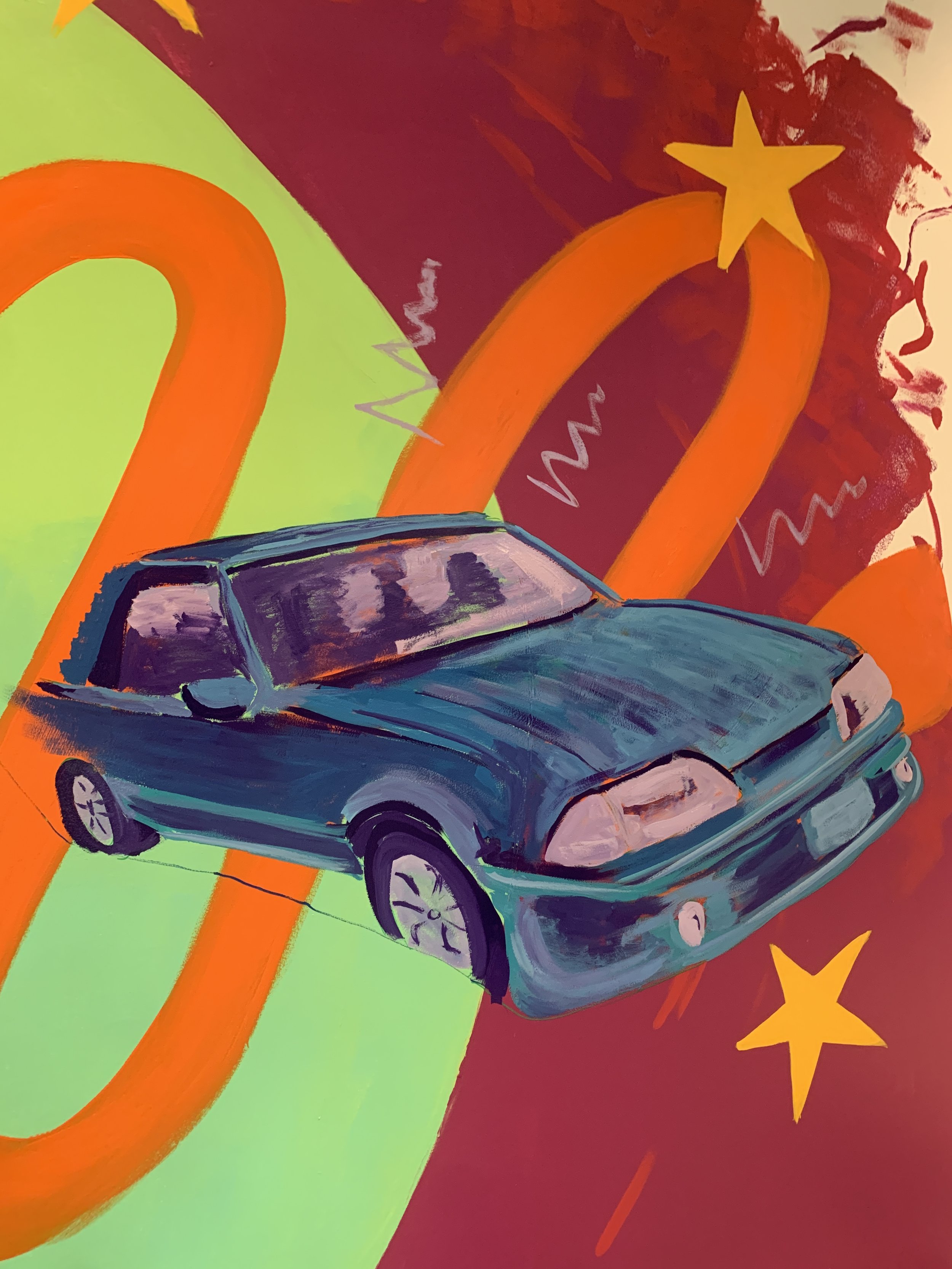Jonathan R. Duchatellier
Latex and acrylic paints, 10’ x 16’, 2023.
Cantor Art Gallery, College of the Holy Cross, Worcester, MA.
(no longer on view)
"I painted a vibrant and symbol-filled mural to honor Jonathan Robert Duchatellier whose life’s story has been shrouded throughout the years here on the Hill. It was during a 2021 campus exploration that I found out about the story of Jonathan. There was a sign in Cafe Babel that explained that the space was dedicated to a student who seemingly had passed away many years ago. Further investigations via google seldom came with information regarding who he was. This did not sit right with me, but I was unsure why. Maybe it was because I was accustomed to memorials being made in the form of grand, bold murals scattered around my childhood neighborhood. I want this piece both to be a commentary about those emotions I felt upon learning more about Jonathan and truly honor someone who was very much like any student today. I understand my privilege and want to use this opportunity for good and am doing so by elevating a life that has been forgotten over the years. I am infatuated by this idea of the piece being eventually covered in a thin sheet of white latex paint yet still remaining within the walls of campus. Jonathan perfectly embodied this notion of appreciating the time you do have with the people and things around you, which I hope viewers do given the short lifespan of the piece."This work was part of a larger group show at the Cantor Art Gallery. Check out more about the show here:
This speech was read out during the 2023 Academic Conference at Holy Cross:
“Murals are fleeting. They're only supposed to be here for a small period of time, given what they are, and that's okay.” - Travis DudaTo answer the question that’s on everyone’s mind, this artwork will be painted over at the conclusion of this show. Someone will walk in with a gallon of a white tinted latex paint and go right over the piece. In all honesty, Dr. Fluke will probably make me do it. But painting over it is a sort of refresh to make way for future shows to be put on without the remnants of the past. It has taken a long time for me to come to this understanding and acceptance. Much of fine art making prioritizes conservation and longevity, but I don’t want that with my work. We as humans try so hard to bring physical things from the past back to the present but attempts are futile. Concrete erodes, buildings get torn down, paint chips, colors fade, humans change, we change. But instead of getting all riled up at this idea, like “oh we have to save it, get a saw carve it out of the wall!” I want you to do something different. And this message is at the center of all of my work: Appreciate the time you do have with it. There’s something about taking the time to appreciate, recognize and understand meanings behind pieces that, then, is so much more important and valuable. It’s about sitting in front of it and allowing your eyes to wander, to let your imagination run wild. These experiences and memories are what we are left with in the end. And having conversations about these people and things that are depicted is what is really important. This idea of living in the moment, perfectly enough, is what I’ve learned Jonathan embodied. When it comes to my murals, I believe in having a rigorous research period that takes into account many factors. It’s not just me coming at this with a random idea but with a deep appreciation for the people involved as a whole. Getting Jon’s family’s permission to do this project was of utmost importance to me and they have graciously allowed me to go through with it. This has been a two-month long research project consisting of many long-winded emails to explain my vision and hours-long Zoom conversations with people close to Jonathan. I really wanted to build an understanding of who he was through speaking with people who knew him best. Let's start at the beginning:I first came across the story of Jonathan Duchatellier in 2021 when I was working on an art project relating to learning about Holy Cross alumni and members of the Worcester community.When exploring campus, looking for potential places to put up some artwork, I came across a sign that explained that the Cafe Babel space was named in his honor. It was a gift of the class of 2005, his class year. There was no adjoining description. He was merely a name. I thought the internet would help but upon searching his name in Google, I was barraged with information relating to the circumstances of his death. He seemed like an afterthought in articles written by big name publications such as the New York Post. This didn’t sit right with me. Growing up in New York City, I was accustomed to large statues, annual block parties and beautiful murals painted in order to honor these people- how could the only thing I find about him be about this? Why was no one else concerned about this? How can I help shift preconceptions people may have upon reading articles like the ones I saw? I reached out to professors at the College that were teaching during that time, his friends here at the College and at his high school and even his parents. I quickly found out that there was so much love for him. I had expected people to deny my emails but instead, I was met with some really beautifully composed responses. It seemed as though people WANTED to speak about Jonathan. We as a society tend to aggrandize people who die young but people here truly admired him for who he was as a human. As someone who has worked with the Worcester community on mural projects and who has been recognized by the school for my achievements, I understand my privilege. I know that I could get by with painting a mural on campus, ruffling some feathers along the way. I felt such a deep desire and duty to shed light on this wonderful role model, who attended the school before I was even born. Throughout the course of this project, he has inspired and motivated me to not lose sight of what's important in life, the people around me and to love them fervently. I hope that with this project, there can be some justice to his legacy in the form of a biography written about him that either goes along with the plaque or that lives on the Holy Cross website, permanently. Jonathan was a student just like any of us here, with interests, big dreams and passions. He was a Haitian-American student who began attending the College in 2001. He came to Worcester after graduating from the Marine Academy of Science and Technology High School in Sandy Hook, New Jersey. He was involved in the Naval JROTC in high school and continued it here as well. He was fluent in French, loved playing soccer and was very into community service. He combined those final two by teaching students how to play soccer at one point. He was incredibly athletic and did well on physical competitions put on by the NJROTC program. Oh and he loved to dance. His friends described him as dynamic, warm-spirited and good natured. His smile was magnetic and you couldn’t help but be in his orbit. I heard stories about him driving his 1987 Ford Mustang GT and blasting Billy Joel, to his mother’s dismay. I learned about his ability to be serious when necessary, like during NROTC events but joking around when in Clark hall with his friends. After interviewing those who knew him best, I digitally composed a design and then physically painted it here on the wall. Stylistically, I took elements from murals that I saw in my neighborhood growing up including the presence of graffiti, especially a halo above the name, a reference to his Christian faith. I wanted this piece to be striking, loud and vibrant and something that you can see from across the hall immediately. The stars are both a reference to his academic achievement as well as his passion for the Naval ROTC program. The ribbons are also a reference to ones that he received in highschool which stand for leadership, community service, Physical Fitness Excellence, and an armed drill excellence. For the background I wanted there to be a lot of movement and a sort of explosion that was his boisterous yet warm personality. I want to leave you with a quote by Banksy: “they say you die twice. One time when you stop breathing and a second time, a bit later on, when somebody says your name for the very last time.” I hope I did my part in continuing conversations about the manner in which we remember people on campus and, of course, about the life of Jonathan Robert Duchatellier. 







